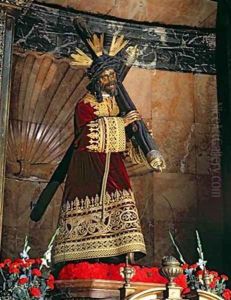Juan de Mesa Paintings
Juan de Mesa, born in Córdoba, Spain, in 1583, was a pivotal figure in the Spanish Baroque sculpture movement, particularly renowned for his religious works. His early life was marked by his move to Seville, where he would eventually study under the tutelage of Juan Martínez Montañés, one of the most prominent sculptors of the time. This mentorship profoundly influenced Mesa's artistic development, embedding in him the principles of the Sevillian school of sculpture, which was characterized by its intense realism and emotional depth.
Mesa's work is distinguished by its dramatic expressiveness and technical precision, qualities that made him a sought-after sculptor for religious brotherhoods and institutions. Among his most celebrated works are the processional figures created for the Holy Week in Seville, a major event in the city's liturgical calendar. His masterpiece, the Jesus del Gran Poder, remains a seminal piece of Spanish Baroque sculpture, admired for its powerful depiction of Jesus Christ and its exquisite craftsmanship. This work, along with others such as the Virgen de la Esperanza and the Cristo de la Buena Muerte, showcases Mesa's ability to convey deep spiritual emotions through his sculptures, making them resonate with viewers on a profoundly emotional level.
Despite his significant contributions to the art world and the high regard in which he was held, Juan de Mesa's life was relatively short. He died in Seville in 1627, leaving behind a legacy that would influence generations of sculptors. His works continue to be venerated, especially in Seville, where they play a central role in the city's religious observances and cultural heritage. Mesa's art not only reflects the religious fervor of his time but also stands as a testament to his exceptional skill and the enduring appeal of the Baroque style in Spanish sculpture.
